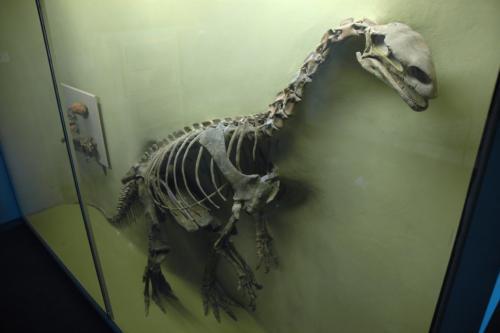
News
When Professors Speak Out, Some Students Stay Quiet. Can Harvard Keep Everyone Talking?

News
Allston Residents, Elected Officials Ask for More Benefits from Harvard’s 10-Year Plan

News
Nobel Laureate Claudia Goldin Warns of Federal Data Misuse at IOP Forum

News
Woman Rescued from Freezing Charles River, Transported to Hospital with Serious Injuries

News
Harvard Researchers Develop New Technology to Map Neural Connections
T-Rex Did Not Have King-sized DNA

The T-Rex may once have been king of the predators, but a new study shows that the reptilian giant may be no match for other dinosaurs and vertebrates when it comes to the size of its DNA.
New research performed at Harvard and the University of Reading has shed light on one of biology’s longest-standing secrets.
The investigation into the DNA of dinosaurs has indicated that theropods—a class of carnivorous dinosaur including the velociraptor and the Tyrannosaurus rex—had a genome smaller than that of most vertebrates and other dinosaurs but about the same size as those of modern birds.
The findings also provide the first real information about the genomes of dinosaurs, according to Professor of Organismic and Evolutionary Biology Scott V. Edwards, who contributed to the study. The study will appear in the March 13 issue of Nature, he said.
The genome of a bird is roughly one-third the size of that of humans and about half the size of reptilian genomes, according to Edwards. Until now, no one knew when birds had developed these irregular genomes, he said.
“We knew that either the genomes shrank and then the first birds evolved, or that birds evolved and then the genomes shrank, or that birds and the shrunk genomes evolved at the same time,” said Chris L. Organ, a post-doctoral fellow in organismic and evolutionary biology who worked on the report.
The team found that the shrinkage occurred 120 to 140 million years before birds first branched off the evolutionary tree.
“There had been some speculation that maybe [dinosaurs] too had some small genomes like birds, but it was based solely on the idea that birds were firmly nested in the dinosaur lineage,” Edwards said.
The researchers said they are still not certain about how such small genomes would have effected dinosaur behavior and physiology.
In a study the lab had conducted a few years ago, the team found that species with smaller genomes tend to have higher metabolisms.
In birds, this makes flight possible, while in dinosaurs, it might mean they were as quick-moving and active as they appear in the film Jurassic Park, Edwards said.
Another member of the research team, Andrew M. Shedlock, a research associate in the department of organismic and evolutionary biology, said that the biggest breakthrough was the scientific and statistical method that the research team developed.
They were able to look at the pockets in dinosaur fossils where cells used to live and compare them to that of modern vertebrates.
“It opens up a program that we can use for other areas of vertebrate biology in a way that wasn’t possible ten years ago,” Shedlock said.
Want to keep up with breaking news? Subscribe to our email newsletter.
